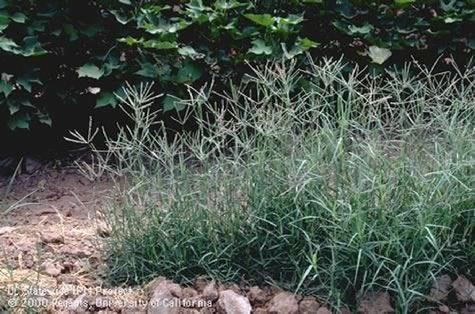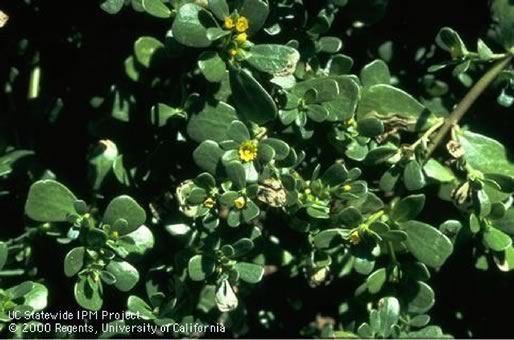Weeds are frequently defined as any plants that grow where they are unwanted. Common weeds are fast growing, resilient nuisances that compete with your cultivated plants for nutrients, water, and sunlight. They can be fire hazards and serve as hosts for pests and diseases. Removal can be time consuming and costly.
The first step in successful weed control is preventing them from becoming well established. Remove new weeds as early as possible, by gentle pulling or shallow digging. Working the soil too deeply will bring up more weed seed. Encourage your students to pull weeds as they sprout and begin to grow. They will gradually learn to distinguish between “good” plants and the weeds by their appearance when the weeds are very small. Never allow weeds to flower and produce seeds. A single weed can produce thousands of weed seeds that can remain in the soil and sprout for many years.
Identifying Weeds
Weed species are either broadleaf (e.g., clover, dandelion and purslane) or grassy type (e.g., annual bluegrass, crabgrass, nutsedge, and bermuda grass). Weeds are also divided into annuals, biennials, and perennials.


Annual weeds complete their life cycle in one season or year. Summer annuals, such as crabgrass, germinate in the Spring and die in the Fall with the onset of colder weather. Winter annuals, such as bluegrass, germinate in Fall and die when warm weather arrives. The seeds they produce during the growing season remain dormant in the soil until the next growing season when soil temperatures rise. A single weed may yield more than 10,000 seeds. Many weed seeds remain viable for decades. Biennial weeds such as cheese weed (broadleaf) grow vegetatively one season, then flower, produce seed and die the following season.
Perennial weeds live for several years. Simple perennials reproduce by seed. Common examples are dandelions, plantains, and chicory. Creeping perennials reproduce by seed, but can also spread by rhizomes, stolons, and underground storage organs such as bulblets. Examples are nutsedge, oxalis, bermuda grass, and kikuyu grass.
Common bermuda grass, yellow nutsedge, and some other perennial weeds are most effectively controlled with a systemic herbicide that is applied before the soil is dug and when weeds are actively growing. NOTE: Always contact the pest control department for your school district if you think herbicide treatment may be needed.
The UC IPM website has two helpful tools: The Weed Identification Tool and a Weed Photo Gallery. The photo gallery includes links to the Pest Note that describes the life cycle of the weed, its impact, and suggestions for controlling the weed.
Preventing Weeds
There are a variety of ways you can minimize the number of weeds in your garden. You might:
-
- Use edging materials such as bricks or underground barriers of metal or plastic around garden beds.
- Plant in raised beds or large containers to keep lawn grass and perennial weeds from creeping into flower and vegetable plots.
- Check nursery plants for weeds before you bring them into the garden.
- Cover the soil around your plants with mulch to deny weeds the light they need to germinate.
- Blanket bare soil with a cover crop, ground cover, or mulch.
- Add to your compost only those weeds that have not bloomed and set seeds.
Controlling Weeds
The potential weed population is boundless. Don’t automatically reach for an herbicide to treat garden weeds. A combination of elbow grease, ingenuity, and tools will usually do the job. There are a variety of ways to control weeds: proper site preparation, cultivation, solarization, mulching, and by preventing seed production.
When preparing the site for planting, turn the soil with a shovel, break up clods, and rake and level the surface. Irrigate and allow weed seeds to germinate. Remove the weeds or let them dry out and die. If a lot of weeds sprout, repeat the process again before you plant.
You can remove weeds by cultivating with a trowel, hoe or shovel. Weeds are easier to pull with their root systems intact and neighboring plants are less likely to be disturbed or damaged if the soil is moist. Be sure to remove any part of the weed that can regenerate. Wild garlic will regrow from little bulblets; plantains have persistent taproots; and bermuda grass can sprout from its deep (6 feet), underground stems (rhizomes). Shallow cultivation and hoeing control the weeds in the surface soil. When soil is worked deeply, new seeds are brought to the surface. Pull weeds as soon as you spot them instead of waiting until later. The longer you wait the harder weeds are to pull, and it gives them the opportunity to spread. Keep a weed bucket in your garden for quick disposal.
Solarizing the Soil
Solarization can greatly reduce the number of weeds and weed seeds in a garden area by capturing sunlight to heat moist soil to temperatures that kill germinating weed seeds.
First, irrigate the area to a depth of 6 inches and sprinkle periodically to encourage weed seeds to sprout. Then cultivate and rake the soil level. Water the soil well and place a sheet of clear plastic 1 to 4 millimeters thick over the area (black plastic absorbs heat but does not transmit heat into the soil as well as clear plastic). The plastic must lie very close to the soil surface to maximize the soil temperatures necessary to kill seeds. Anchor the edge of the tarp by burying it in a shallow soil trench around the plot. Be sure to repair any rips in the plastic to insure an air-tight cover and maintain maximum soil temperatures. Solarize during the summer months to best utilize the high temperatures and high light intensities. Wait 4 to 6 weeks while the sun heats the soil and roasts the weed seeds. Remove the plastic and allow the soil to dry slightly before planting. Do not cultivate soil deeply as this will bring more viable weed seeds to the surface. NOTE: Solarization works best in hotter inland areas and may not be as effective near the coast due to cooler temperatures and cloudy weather.
